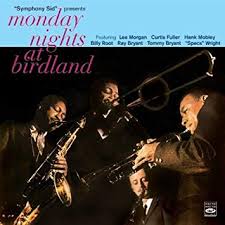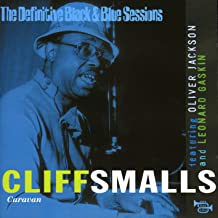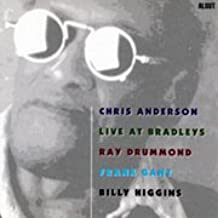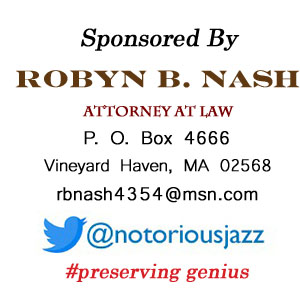
Daily Dose Of Jazz…
William “Billy” Root was born March 6, 1934 in Philadelphia, Pennsylvania and was raised in a musical family, his father played drums in Philadelphia ensembles.
Root began playing professionally in the early 1950s, with Roy Eldridge, Hal McIntyre, Red Rodney, Bennie Green, and Buddy Rich. Later in the decade he worked extensively with Stan Kenton and with Rodney, as well as with Clifford Brown, Dizzy Gillespie, Hank Mobley, Lee Morgan, and Curtis Fuller.
He led his own ensembles from the late 1950s. In the 1960s he performed with Al Grey and Dakota Staton, and in 1968 settled in Las Vegas, Nevada. Saxophonist Billy Root played the casinos for the next two decades before retiring.
More Posts: bandleader,history,instrumental,jazz,music,saxophone

Daily Dose Of Jazz…
Cliff Smalls was born Clifton Arnold on March 3, 1918 and was raised in Charleston, South Carolina. His father, a carpenter, performed piano and organ for Charleston’s Central Baptist Church. He taught Smalls classical music at an early age. He left home with the Carolina Cotton Pickers and also recorded with them, for instance, Off and on Blues and “Deed I Do, which he arranged and featured Cat Anderson in 1937 when he was 19.
With his career coinciding with the early years of bebop, from 1942 to 1946 he was a trombonist, arranger and also backup piano-player for band-leader and pianist Earl Hines, alongside Dizzie Gillespie and Charlie Parker. While in the Hines band he performed often during broadcasts seven nights a week on open mikes coast-to-coast across America. Hines also used Teddy Wilson, Jess Stacy and Nat “King” Cole as backup piano-players but Smalls was his favorite. He also played in the Jimmie Lunceford and Erskine Hawkins bands.
After the inevitable post-World War II breakup of the Hines big-band, Cliff went on to play and record in smaller ensembles with his former Earl Hines band colleagues, singer and band-leader Billy Eckstine, trombonist Bennie Green, saxophonist Earl Bostic and singer Sarah Vaughan. In 1949 he recorded with JJ Johnson and Charlie Rouse. He was the pianist on Earl Bostic’s 1950 hit Flamingo along with John Coltrane but had a serious automobile accident, with Earl Bostic, in 1951 and laid in bed all of 1952, till March of 1953.
Recovering, Smalls shifted his musical career to serve as music director/arranger for singers Eartha Kitt, Ella Fitzgerald, Sammy Davis, Jr., Smokey Robinson and the Miracles, Clyde McPhatter, Roy Hamilton and Brook Benton. He recorded Bennie Green with Art Farmer in 1956 and was, for many years, a regular with Sy Oliver’s nine-piece Little Big-Band from 1974-1984, a regular stint in New York’s Rainbow Room.
In the 1970s he returned to jazz-recording, including four solo tracks for The Complete Master Jazz Piano Series in 1970, with Sy Oliver in 1973, Texas Twister with Buddy Tate in 1975, Swing and Things in 1976 and Caravan in France in 1978. In 1980 Smalls was featured playing piano in The Cotton Club, directed by Francis Ford Coppola. Trombonist, pianist, conductor and arranger Cliff Smalls, who worked in the jazz, soul and rhythm & blues genres, passed away in 2008.
More Posts: arranger,bandleader,conductor,history,instrumental,jazz,music,piano,trombone

Daily Dose Of Jazz…
Chuck Wayne was born Charles Jagelka on February 27, 1923 in New York City to a Czechoslovakian family. As a boy, he learned banjo, mandolin, and balalaika. By the early 1940s he was playing in jazz bands on 52nd Street and after two years in the Army, he returned to New York City, joined Joe Marsala’s band, and settled in Staten Island until a 1991 move to New Jersey. He changed his musical style after hearing Charlie Parker, recording with Dizzy Gillespie in 1945. Frustrated with the difficulty of getting the sound he wanted, he considered switching to saxophone.
Wayne was a member of Woody Herman’s First Herd, the first guitarist in the George Shearing quintet, worked with Coleman Hawkins, Red Norvo, Bud Powell, Jack Teagarden, George Shearing, Lester Young, and Barbara Carroll. During the 1950s, he played with Tony Bennett, Gil Evans, Brew Moore, Zoot Sims, and George Wallington. In the Sixties, CBS hired him as a staff guitarist and for the next two decades, he played on Broadway, accompanied vocalists, and performed in guitar duos with Joe Puma and Tal Farlow.
He wrote Sonny in honor of Sonny Berman. Years later, Miles Davis took the song, renamed it Solar, and claimed he wrote it. His Butterfingers and Prospecting have been incorrectly attributed to Zoot Sims. Chuck was known for a bebop style influenced by saxophone players of his time and he developed a technique not widely adopted, and also developed a comprehensive approach to guitar chords and arpeggios.
Over the course of his career, he recorded eight albums as a leader beginning with his 1953 album The Chuck Wayne Quintet on the Progressive label. He worked as a sideman with Gil Evans, Anthony Perkins, Dick Katz, Duke Jordan, and Frank Wess, among others. Guitarist Chuck Wayne, one of the first jazz guitarists to learn bebop, passed away on July 29, 1997.
More Posts: bandleader,guitar,history,instrumental,jazz,music

Daily Dose Of Jazz…
Chris Anderson was born on February 26, 1926 in Chicago, Illinois and was a self-taught pianist. He began playing in Chicago clubs in the mid-1940s and played with Von Freeman and Charlie Parker, among others. Hired as Dinah Washington’s accompanist in New York City, his tenure with Washington was a brief six weeks as she changed accompanists frequently. After his firing, he decided to stay in the city.
In 1960 he recorded what might be his best-regarded album My Romance on the VeeJay label with bassist Bill Lee and drummer Art Taylor. He was a great influence on his student Herbie Hancock.
Despite the respect of his peers, Anderson had difficulty finding work or popular acclaim due in large to his disabilities. He was blind and his bones were unusually fragile, causing numerous fractures, which at times compromised his ability to perform at the times or places requested, although he continued to record until he was well into his 70s. A DownBeat profile indicated he had osteogenesis, probably meaning osteogenesis imperfecta.
He would record his first album as a leader in 1960 and ultimately record a total of ten. As a sideman, he worked with Charlie Haden, Clifford Jordan, Sun Ra, and Frank Strozier. Pianist Chris Anderson passed away on February 4, 2008 in Manhattan, New York City.
More Posts: bandleader,history,instrumental,jazz,music,piano

Daily Dose Of Jazz…
Baby Laurence was born Laurence Donald Jackson on Feb 24, 1921 in Baltimore, Maryland. He was a boy soprano at age twelve, singing with McKinney’s Cotton Pickers. When the bandleader Don Redman came to town and heard Jackson, he asked his mother if he could take the boy on the road. She agreed, providing her son traveled with a tutor. Touring on the Loewe’s circuit, his first time in New York City was marked by a visit to the Hoofers Club in Harlem, where he saw the tap dancing of Honi Coles, Raymond Winfield, Roland Holder, and Harold Mablin.
>Returning home sometime later he discovered both his parents had died in a fire. He and his brother formed a vocal group called The Four Buds and tried to establish themselves in New York. He worked in the Harlem nightclub owned by the retired dancer Dickie Wells, who nicknamed him “Baby” and encouraged his dancing. He frequented the Hoofers Club, absorbing ideas and picking up steps from Eddie Rector, Pete Nugent, Toots Davis, Jack Wiggins, and Teddy Hale, who became his chief dancing rival. Baby worked after-hour sessions, danced around Harlem, Washington, D.C., and Cincinnati, and began playing theaters such as Harlem’s Apollo in the late 1930s. He performed with a group called The Six Merry Scotchmen or the Harlem Highlanders, who dressed in kilts, danced, and sang Jimmie Lunceford arrangements in five-part harmony.
By 1940 Baby was focused on tap dancing and became a soloist. Through the decade, he danced with the big bands of Duke Ellington, Count Basie and Woody Herman, and in the Fifties danced in small Harlem jazz clubs. Under the influence of jazz saxophonist Charlie Parker and other bebop musicians, Laurence expanded tap technique into jazz dancing. He performed with Art Tatum, duplicating in his feet what Tatum played with his fingers. Through listening hard to Parker, Dizzy Gillespie, and Bud Powell as well as drummers like Max Roach, he developed a way of improvising solo lines and variations as much as a horn man as a percussionist.
Beset by drugs, alcohol, and financial troubles, Laurence stopped performing in the late fifties. After a long illness, he returned to Harlem in the early sixties to work again in small jazz clubs. Baby began a long time engagement with Charlie Mingus, danced with Max Roach, and would go on to tap dance sessions at the Jazz Museum, dance with Josephine Baker, did some television and gave one of his triumphant performances at the Newport-New York Jazz Festival.
Regarded as an authentic jazz dancer, he further developed the art of tap dancing by treating the body as a percussive instrument. Baby Laurence, an extraordinary jazz tap dancer who had a profound influence on rhythm dancers in the second half of the twentieth century, passed away on Apr 2, 1974.
More Posts: dance,history,instrumental,jazz,music



